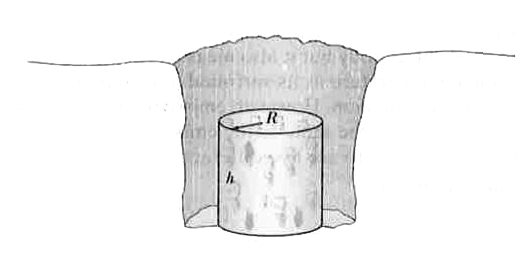Unlike most other plants, a special type of cabbage called skunk cabbage can regulate its internal temperature ( set at T = 22∘C )by altering the rate at which it produces energy. If it becomes covered with snow, it can increase that its thermal radiation metls the snow in order to re-expose the plant to sunlight. Let's model a skunk cabbage with a cylinder of height h = 5.0 cm and radius R = 1.5 cm and assume it is surrounded by a snow wall at temperature Tenv=−3.0∘C (Figure) . If the emissivity ε is 0.80, what is the net rate of energy exchange via thermal radiation between the plant's curved side and the snow ?

Video Solution
Text Solution
(1) In a steady-state situation, a surface with area A, emissivity ε, and temperature T loses energy to thermal radiation at th erate given by Equation (Prad=σεAT) (2) Simultaneously , it gains energy by thermal radiation from its environment at temperature Tenv at the rate given by Equation (Pabs=σεAT4env)
Calculations : To find the net rate of energy exchange, we subtract Equation from Equation to write
Pnet=Pabs−Prad
=σεA(T4env−T4) ( 19 - 27)
We need the area of the curved surface of the cylinder, which is A=h(2πR) . We also need the temperature in kelvins. Tenv=273K−3K=270K and T=273K+22K=295K. Substituting in Equation for A and then substituting known values in SI units ( which are not displayed here ). we find
Pnet=(5.67×10−8)(0.80)(0.050)(2π)(0.015)(2704−2954)=−0.48W
Thus, the plant has a net loss of energy via thermal radiation of 0.48 W. The plant.s energy production rate is comparable to that of a hummingbird in flight.
|
Similar Questions
Knowledge Check
Edible part of cabbage is
AFruitBAn inflorescenceCA vegetative budDA flowerEdible part of cabbage is
AStem tuberBA budCInflorescenceDRootFloral formula of cabbage is
A B
B C
C D
D
The rosette habit of cabbage can be changed by applicaton of
View SolutionThe temperature of a black body is increased from 7∘C to 567∘C, then the rate of energy radiation becomes
View SolutionWhen a plant is not reproducing, most of its cytokinins are produced in its
View SolutionWalking becomes difficult, When the ground is covered with snow or sand this is because
View SolutionThe process by which a new plant can be produced from its seeds starts with :
View Solution
